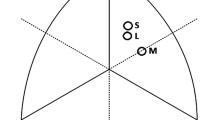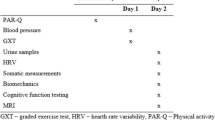Abstract.
This study describes the distribution of blood lipid concentrations and examines relationships among training volume (TV, kilometers per week), peak oxygen consumption (\(\dot V{\rm O}_{2{\rm peak}} \) ), body fatness, and blood lipid concentrations in 48 male and 22 female distance runners, aged 10–19 years. Comparisons were made to a current reference sample and clinical cut-off points. Relationships were assessed by partial correlations allowing for age and sexual maturity. Compared to reference median values, mean concentrations of total cholesterol (P=0.07) and low density lipoprotein-cholesterol (P<0.005) were higher, while high density lipoprotein-cholesterol (HDL-C; P=0.24) was comparable in male distance runners. Blood lipid concentrations in female distance runners were comparable to reference median values. Although some subjects had dyslipidemic values, most possessed clinically normal concentrations of blood lipids. The TV was weakly correlated with blood lipid concentrations, but may have been indirectly related with HDL-C through its relationship with \(\dot V{\rm O}_{2{\rm peak}} \) in males runners (r=0.32). In female runners, correlations between sum of skinfolds (SSF), the trunk-to-extremity ratio (TER) and blood lipid concentrations were low (r=0.16 to –0.27), with one exception (TER and HDL-C, r=–0.60). The most consistent relationships existed among TV, \(\dot V{\rm O}_{2{\rm peak}} \) , SSF, and HDL-C with partial correlations ranging from low (r=0.10 TV) to moderate (r=0.37 SSF, r=0.41 \(\dot V{\rm O}_{2{\rm peak}} \) ). The correlation between \(\dot V{\rm O}_{2{\rm peak}} \) and HDL-C remained significant after allowing for age and SSF, while the partial correlation between SSF and HDL-C, allowing for age and \(\dot V{\rm O}_{2{\rm peak}} \) , was reduced and not significant (r=–0.19, P=0.20). In female runners, the correlation between \(\dot V{\rm O}_{2{\rm peak}} \) and HDL-C was r=0.32, whereas the partial correlation between SSF and HDL-C, allowing for age and \(\dot V{\rm O}_{2{\rm peak}} \) , was r=0.00. Blood lipid concentrations of young male distance runners were not, on average, different to the general population of the youth of the United States. The young distance runners showed considerable heterogeneity in blood lipid phenotypes, including dyslipidemic values. The results highlight the complex relationships among TV, \(\dot V{\rm O}_{2{\rm peak}} \) , body fat and HDL-C, and indicate the unique contribution of \(\dot V{\rm O}_{2{\rm peak}} \) as an important predictor of HDL-C in young distance runners.
Similar content being viewed by others
Author information
Authors and Affiliations
Additional information
Electronic Publication
Rights and permissions
About this article
Cite this article
Eisenmann, J.C., Womack, C.J., Reeves, M.J. et al. Blood lipids of young distance runners: distribution and inter-relationships among training volume, peak oxygen consumption, and body fatness. Eur J Appl Physiol 85, 104–112 (2001). https://doi.org/10.1007/s004210100445
Accepted:
Issue Date:
DOI: https://doi.org/10.1007/s004210100445




